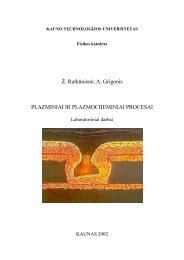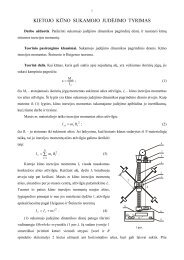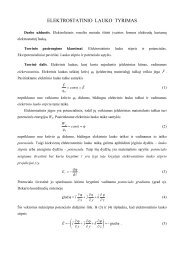PROCEEDINGS OF THE 7 INTERNATIONAL ... - Fizika
PROCEEDINGS OF THE 7 INTERNATIONAL ... - Fizika
PROCEEDINGS OF THE 7 INTERNATIONAL ... - Fizika
You also want an ePaper? Increase the reach of your titles
YUMPU automatically turns print PDFs into web optimized ePapers that Google loves.
T. Landberg et al. / Medical Physics in the Baltic States 7 (2009) 43 - 51<br />
specification for reporting, the margin that defines the<br />
PTV will have to be a closed line, even if this may not<br />
be necessary for the proper selection of beam<br />
parameters. It may be advantageous, but is probably<br />
often not feasible for different reasons, to display also<br />
the borders of the Internal Target Volume.<br />
Note that in some cases, the Internal Margin approaches<br />
a very low value, (e.g. with brain tumors), and in other<br />
cases the Set-up Margin may be very small (e.g. with online<br />
correction for the different set-up errors and<br />
variations).<br />
Ideally, the size of the margins should be determined in<br />
an iterative way during the selection of an optimal beam<br />
arrangement, e.g. in beam´s eye view (as when planning<br />
both co-planar or non-coplanar conformal therapy). In<br />
practice this may not always be feasible, and as a<br />
compromise one can specify the margins for uncertainty<br />
in such a way, that they can be used for different types<br />
of beam arrangement (e.g. one beam, two opposed<br />
beams, box technique, orthogonal beams, moving beam).<br />
In daily clinical use, this is probably the most feasible<br />
way to go when defining the PTV for treatment planning<br />
and for basic dose specification for reporting, and is the<br />
approach recommended in ICRU Report # 50, 1993.<br />
Depending on the clinical situation (e.g. patient<br />
condition and site of the CTV), and the chosen<br />
technique, the PTV could be very similar to the CTV<br />
(e.g. small skin tumors, pituitary tumors), or by contrast<br />
much larger (e.g. lung tumors). Since the PTV is a<br />
purely geometric concept, but has to be related to the<br />
basic anatomical description, it may surpass normal<br />
anatomical borders (e.g. include parts of clinically<br />
unaffected bony structures), or even extend outside the<br />
patient (e.g. in a case of tangential irradiation of the<br />
breast [Fig. 4]) if the basic anatomy is presented in a<br />
static way (which for the moment seems in general to be<br />
the only realistic method). The problem is of course a<br />
fundamental one: how can one combine a static dose<br />
calculation with a moving CTV? One has to accept the<br />
use of rather artificial methods, and in a situation as<br />
described above, it is recommended that, for the purpose<br />
of treatment planning (dose calculation in air will of<br />
course not be meaningful) and for evaluation of the dose<br />
distribution to add “constructed tissue” (see Fig. 6) to the<br />
static, “frozen” reference situation (e.g. to a transverse<br />
section). As a compromise, the width (thickness) of this<br />
slice of “constructed tissue” can be chosen to agree with<br />
the average of the position of PTV with different degrees<br />
of variations and uncertainties (e.g. different phases of<br />
respiration). It may not be necessary to add all<br />
uncertainties due to the movements and spatial<br />
variations linearly (Fig. 4 & 5). Some of the movements<br />
and variations previously listed could deviate<br />
systematically at the time of the irradiation compared to<br />
the planning process. Other uncertainties may vary at<br />
random. If the random uncertainties are normally<br />
distributed and the systematic uncertainties are estimated<br />
by their standard deviations, the combined effect can be<br />
estimated. The total standard deviation is then the root of<br />
the square sum of random and systematic uncertainties.<br />
It should be realized that the different variations and<br />
46<br />
uncertainties may be either symmetric or anisotropic,<br />
and they may be independent, counter-variate, or covariate.<br />
The size may differ for different parts of a<br />
CTV (e.g. base versus apex of the bladder and<br />
prostate), and the temporal conditions may vary (e.g.<br />
with the respiratory cycle). The situation may be quite<br />
different for a single patient from that for a random<br />
patient population.<br />
The PTV is thus the volume that is used for dose<br />
calculation, and the dose distribution to the PTV has<br />
to be considered to be representative of the dose<br />
distribution to the corresponding CTV. Since the<br />
Planning Target Volume is a static, geometrical<br />
concept, used for treatment planning, it does not in<br />
fact represent defined tissues or tissue borders.<br />
Actually, the tissues contained geometrically within<br />
the PTV may not truly receive the planned dose<br />
distribution; at least not in some parts close to its<br />
border. This is due to the variation in position of the<br />
CTV within the boundaries of the PTV during a<br />
course of treatment. When delineating the PTV,<br />
consideration should also be given to the presence of<br />
any radiosensitive normal tissue (Organs at Risk, see<br />
below). This may lead to the choice of alternative<br />
beam arrangements and/or shapes as part of an<br />
optimization procedure. In some cases it may be<br />
necessary to change the prescription (for volumes<br />
and/or doses), and then accept a smaller benefit.<br />
When, for radical treatments, the probability of<br />
benefit approaches a low value, then the aim of<br />
therapy may shift from radical to palliative.<br />
Note that the definition of the Planning Target Volume<br />
(PTV) in Reports # 62, and #71 (ICRU 1999, and<br />
2004) is identical to that in the previous Report # 29<br />
ICRU 1978, and Report # 50 ICRU 1993 definition of<br />
"Target Volume". The two concepts are thus<br />
synonymous.<br />
Penumbra and Dose Gradients.<br />
The penumbra is not included in the PTV. The beam<br />
aperture has to be increased in order to compensate for<br />
the penumbra.<br />
Organs at Risk (OR)<br />
("Critical Normal Structures").<br />
Organs at risk are normal tissues whose radiation<br />
sensitivity may significantly influence treatment<br />
planning and/or prescribed dose (e.g. spinal cord). The<br />
dose-volume response of normal tissues is a complex<br />
and gradual process. It depends on earlier effects<br />
induced long before depletion of stem cells or<br />
differentiated cells that in addition may have a<br />
complex structural and functional organization. For<br />
the analysis of volume-dependence of the doseresponse<br />
parameters, it has been suggested that the<br />
tissues of an Organ At Risk can be considered to be<br />
organized in “Functional Sub Units, (FSUs), and the<br />
concepts of “serial”, “parallel”, and “serial-parallel”<br />
organizations of the normal structures (Fig. 3) has<br />
been suggested. For example, the spinal cord has a








